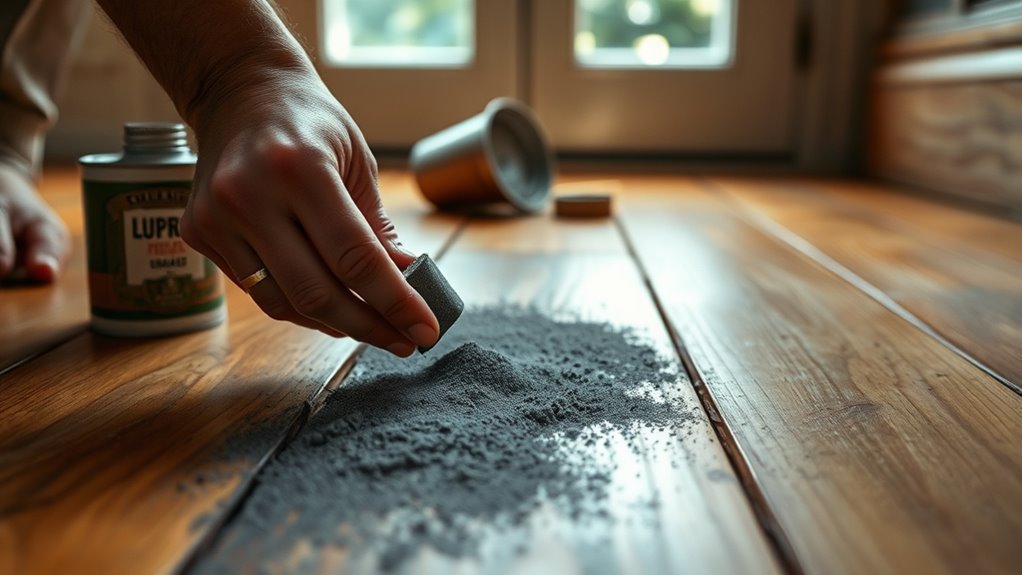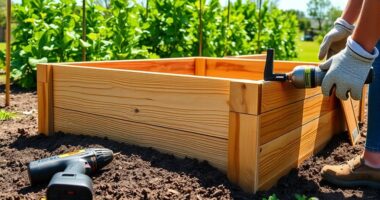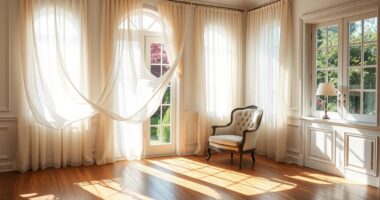To fix squeaky floors quickly, first identify the source of the squeak by walking over the area while someone listens from below. Next, you can lubricate the hardwood with powdered graphite to reduce friction. If that doesn’t work, fill any gaps with shims or drive screws from above into the subfloor for a tighter fit. For carpeted areas, use a Squeeeeek-No-More Kit to secure the joist. Stick around to explore more detailed repair methods!
Key Takeaways
- Identify squeaky spots by walking on the floor and listening from below to locate the source accurately.
- Lubricate affected areas with powdered graphite to reduce friction and silence squeaks quickly.
- Drive screws from above into the floorboards to secure them and eliminate noise without damaging aesthetics.
- Fill gaps between joists and subfloor with shims to stabilize loose floorboards and prevent squeaking.
- Use a Squeeeeek-No-More Kit for quick fixes if you have carpeted floors, securing the joist without visible damage.
Identify the Source of the Squeak
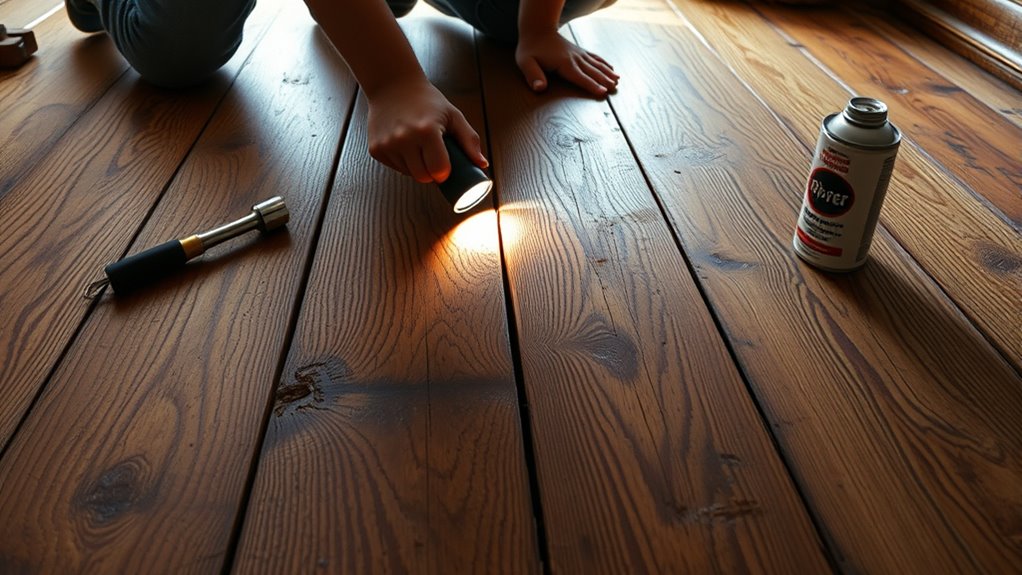
How can you effectively pinpoint the source of that annoying squeak in your floors? Start by having a helper walk over the floor while you listen from below. This will help you identify the source of the squeak more accurately.
Grab a flashlight to inspect the area beneath the floor, looking for exposed nails or screws that could be the culprits. A joist finder can also assist in determining the direction of the joists, which typically run front to back, aiding you in locating the squeaky area.
Apply weight to suspected spots to test for squeaks, revealing which floorboards or joints are problematic. Don’t forget to mark these spots on the joists for easier reference when planning your repair strategy.
Lubricate Hardwood Floors
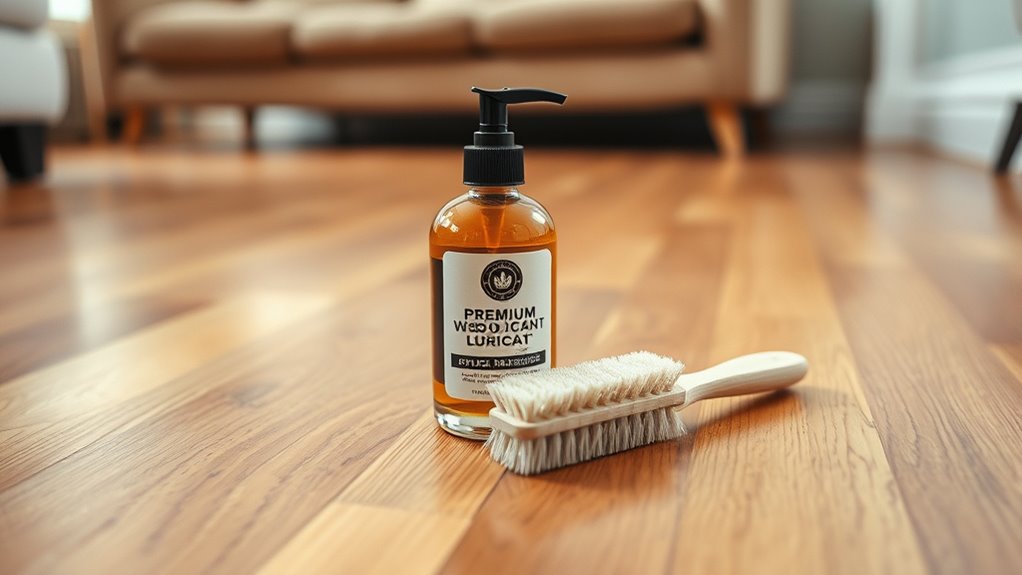
To lubricate your hardwood floors and silence those squeaks, start by sprinkling powdered graphite on the affected area.
Cover it with paper towels and walk over it to work the lubricant into the floorboards.
If the squeak lingers, repeat the process and vacuum up any excess graphite for a clean finish.
Powdered Graphite Application
If you’re dealing with squeaky hardwood floors, applying powdered graphite can be an effective solution to silence those annoying noises.
Start by sprinkling the powdered graphite directly into the gaps between the floorboards where the squeaks are originating. This lubricant will reduce friction and help eliminate the sounds.
Once you’ve applied the graphite, cover the area with paper towels to keep it in place and prevent any mess. To guarantee the graphite works effectively, walk over the treated area, helping it settle into the grooves of the floorboards.
If squeaks persist, don’t hesitate to repeat the application. Remember to vacuum up any excess to keep your space looking clean. Regular use in high-traffic areas can also prevent future squeaks.
Cover and Work In
After applying powdered graphite to the gaps in your hardwood floors, the next step is to guarantee it works effectively by covering and working it in. Place paper towels over the treated areas to keep the graphite in place, then walk over them to work the lubricant into the grooves. This method reduces friction, helping to eliminate those annoying squeaky sounds. If you still hear squeaks, repeat the process for better results.
| Step | Action | Emotion |
|---|---|---|
| Step 1 | Cover with paper towels | Relief |
| Step 2 | Walk to work it in | Satisfaction |
| Step 3 | Enjoy quieter wood floors | Joy |
Regular maintenance in high-traffic areas will keep your floors squeak-free longer.
Clean Excess Lubricant
Cleaning up excess lubricant is essential for maintaining the appearance and safety of your hardwood floors. After applying powdered graphite lubricant, cover the treated area with paper towels to keep the powder in place.
Once you’ve worked the lubricant into the grooves by walking over the area, it’s time to clean excess lubricant. Use a vacuum to remove any leftover powder from the surface, ensuring your floors look tidy and presentable.
If the squeak persists, don’t hesitate to repeat the lubrication process for the best results. Regularly cleaning excess lubricant not only enhances the aesthetic of your hardwood but also helps reduce friction, prolonging its life and preventing further damage.
Fill in Gaps With a Shim
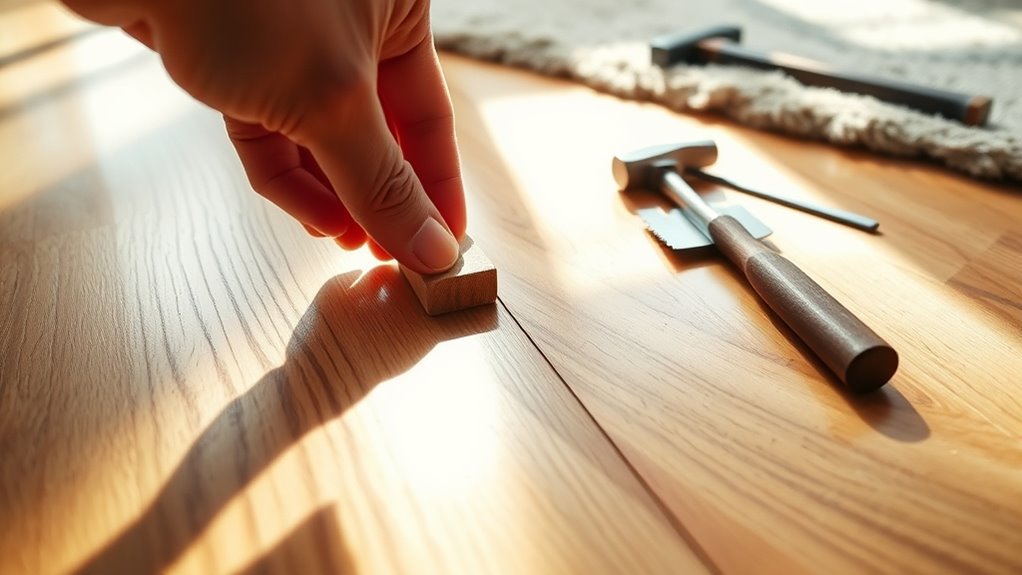
To tackle those squeaky floors, start by identifying where the gaps are between the joists and the subfloor.
Once you’ve pinpointed the squeak locations, apply construction adhesive to one end of your shim.
Gently slide it into the gap to help reduce noise and add support to your floor.
Identify Gap Locations
Squeaky floors can be a frustrating annoyance, often caused by gaps between the floor joists and the subfloor.
To identify these gaps, walk across the floor and listen for squeaks. Pay attention to areas that feel bouncy or unstable, as they often indicate wider gaps. Use a flashlight to inspect beneath the floor, looking for spaces where the joist meets the subfloor.
Once you’ve pinpointed the gaps, you can prepare to fill them. Remember, shims are your best friend here—these small wedges can effectively close the gaps. Just make sure you only insert the shim partially to avoid additional pressure, which might lead to more noise.
Apply Construction Adhesive
If you want to effectively eliminate those annoying floor squeaks, applying construction adhesive to your shims is key.
Start by applying the adhesive to one end of a shim before sliding it into the gap between the joists and the subfloor. Insert the shim partially to avoid increasing the squeak while ensuring it fills the gap properly.
Use a gentle tapping motion to position the shim snugly, taking care not to damage surrounding materials. It’s a good idea to have someone walk on the floor above while you listen for squeaks to check the shim’s effectiveness.
Finally, allow the construction adhesive to cure fully according to the manufacturer’s instructions before testing for squeaks again.
Drive Screws From Above

While addressing squeaks in your floors, driving screws from above can be an effective solution, especially when you can’t access the basement.
Here’s how to do it:
- Drill pilot holes at an angle, making certain they’re at least 1/2 inch from the edge of the boards to prevent splitting.
- Use trim screws that penetrate the subfloor without breaking through the hardwood surface.
- After installing the screws, fill the pilot holes with matching wood filler for a clean finish.
Once you’ve completed the installation, always check for remaining floor squeaks to confirm your fix worked. This method not only repairs the noise but also maintains your floor’s aesthetic appeal. Additionally, addressing emotional well-being through such home improvements can enhance your overall living experience.
Fix Squeaky Floors With Carpeting
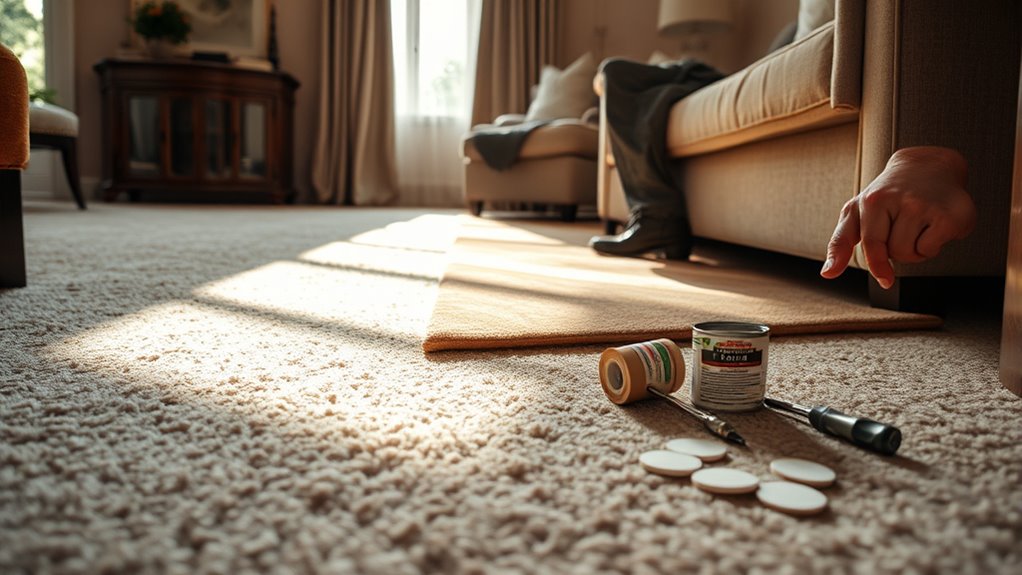
When you’re dealing with squeaky floors under carpeting, pinpointing the source is your first step.
Use a stud finder or walk on the carpet to locate the nearest floor joist to the squeak. Once you’ve identified it, grab a Squeeeeek-No-More Kit.
Position the depth-control fixture over the joist and drive a special breakaway screw through the carpet and subfloor directly into the joist. After securing the screw, remove the fixture and snap off the screw head just below the carpet’s surface to avoid visible damage.
If you hear more squeaks, measure 16 inches from the first joist to find and secure additional joists.
Finally, patch any small holes to keep your carpet looking smooth and intact.
Repairing Squeaky Floors From Below

Fixing squeaky floors from above can be effective, but addressing the issue from below often provides a more permanent solution.
Start by having someone walk on the floor above while you listen for squeaks. Mark the spots on the joists to pinpoint the trouble areas.
Here’s what you can do next:
- Apply carpenter’s glue to a thin wood shim and tap it into the gap between the joist and subfloor.
- Drive a 1 1/4-inch drywall screw at an angle through the shim into the subfloor for added support, ensuring the screw head is flush.
- Consider using a Squeak-Ender, mounting a plate to the subfloor, and tightening a rod against the joist.
Securely install screws and shims to eliminate those pesky squeaks.
Preventive Measures for Future Squeaks
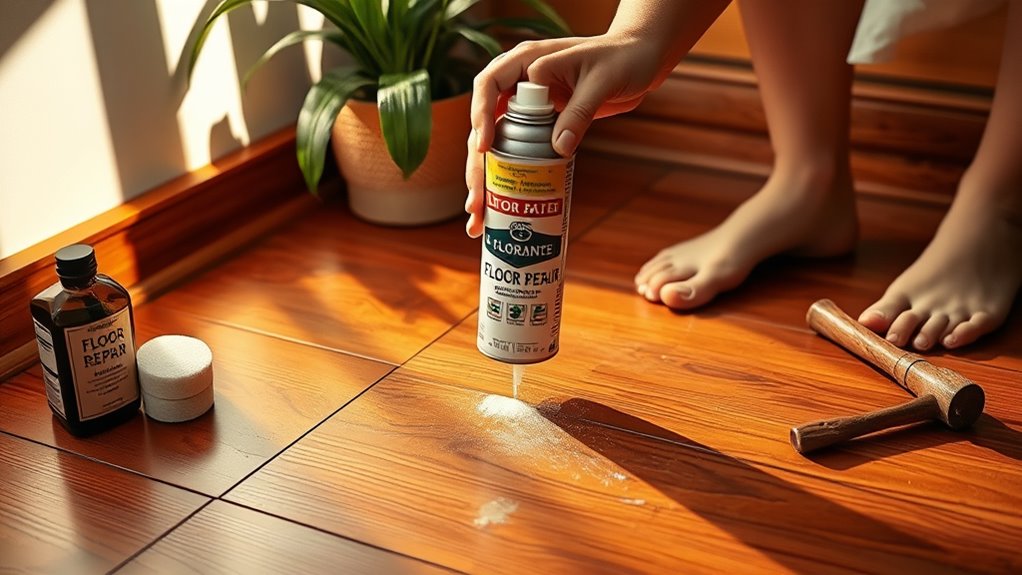
To prevent future squeaks in your floors, it’s crucial to implement proper installation techniques right from the start. Using construction adhesive along with nails or screws can minimize squeaking. Also, leaving expansion gaps around the room allows for natural wood movement, reducing the risk of noise.
| Preventive Measures | Importance | Tips for Implementation |
|---|---|---|
| Use construction adhesive | Reduces squeaks | Apply during installation |
| Guarantee dry, level subfloor | Prevents future issues | Check moisture levels |
| Apply lubricants annually | Reduces friction | Focus on high-traffic areas |
Regular maintenance is important. Address water damage promptly and make sure you have access to the underside for any repairs. These steps will keep your floors quiet and squeak-free.
Frequently Asked Questions
What Is the Easiest Way to Fix Squeaky Floors?
If you’re looking for the easiest way to fix squeaky floors, start by identifying the source of the noise.
You can sprinkle some powdered graphite lubricant into the seams between the floorboards to reduce friction.
Alternatively, you might want to drive screws from above into the subfloor, ensuring they’re positioned correctly to avoid splitting.
Regular maintenance, like tightening loose fasteners, can also help prevent future squeaks from becoming an issue.
Why Does My Floor Creak When I Walk on It?
You might think your floor creaks due to age, but it’s often about how the boards interact.
When you walk, pressure can cause loose floorboards to rub against each other or the joists beneath. This friction creates that annoying noise.
Additionally, gaps formed by environmental changes, like humidity, can worsen the issue.
What Is the Best Lubricant for Squeaky Floors?
When it comes to the best lubricant for squeaky floors, you’ll want to contemplate powdered graphite. It effectively reduces friction between the floorboards, making it a top choice.
Talcum powder’s another popular option; you can sprinkle it between the boards to silence those annoying creaks. Just be sure to apply it carefully and clean up any excess afterward to keep your floors safe and free from buildup.
Reapplication might be necessary if squeaks persist.
Does Baby Powder Fix Squeaky Floors?
If you’re seeking a simple solution, baby powder can temporarily silence those pesky squeaks. Sprinkle it between the floorboards where the noise occurs, then step around to work it in.
While this quick fix might bring a brief blissful break from bothersome sounds, don’t expect lasting results; you’ll likely need to reapply.
For squeaks that persist, consider exploring other effective options for a more enduring fix. Always clean up excess powder to avoid dust dilemmas.
Conclusion
In summary, tackling squeaky floors doesn’t have to be an intimidating task. By pinpointing the source and applying some simple fixes, you can silence those creaks in no time. Whether you’re lubricating hardwood, shimming gaps, or securing screws, a little effort goes a long way. Remember, an ounce of prevention is worth a pound of cure, so take steps to keep your floors quiet moving forward. Enjoy your peaceful, squeak-free home!
